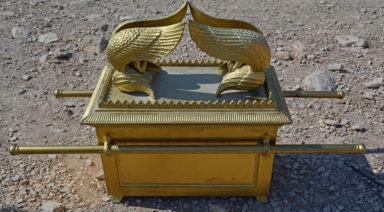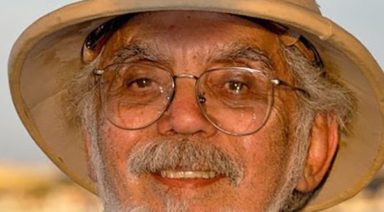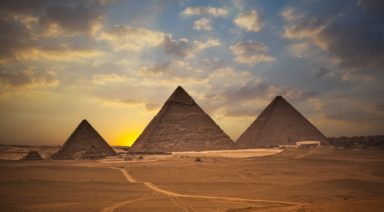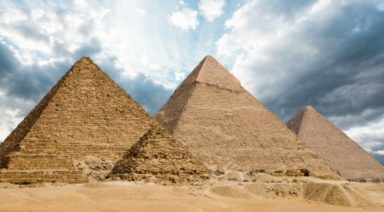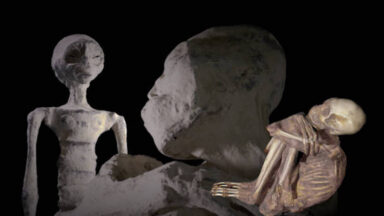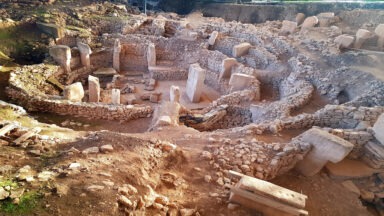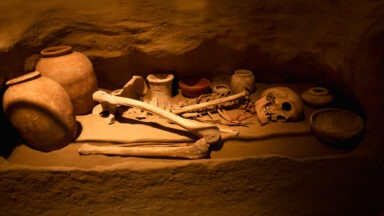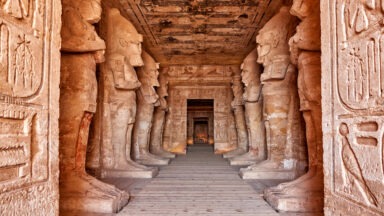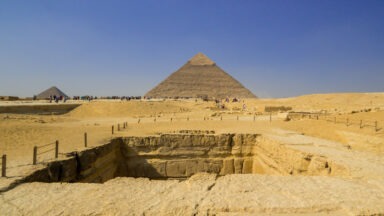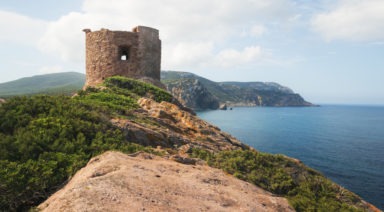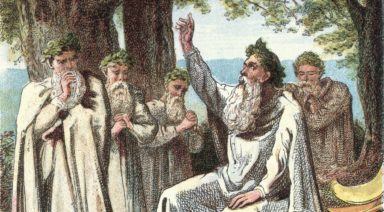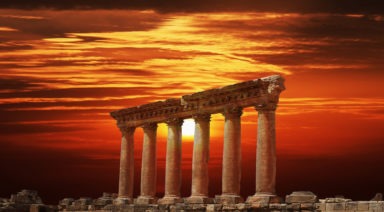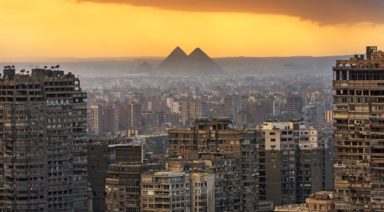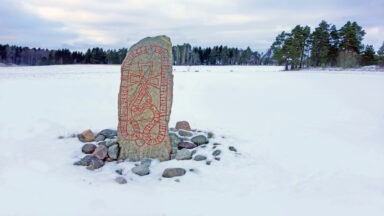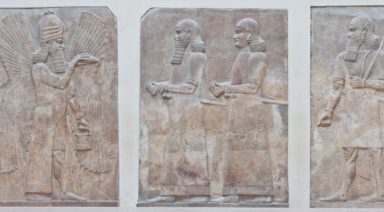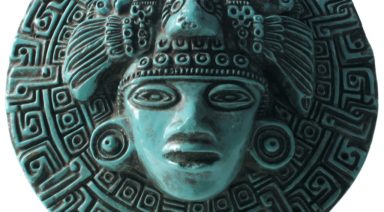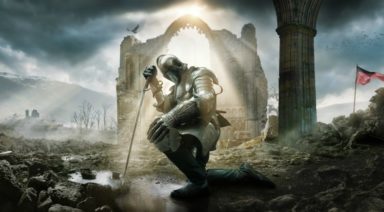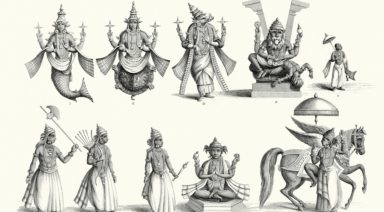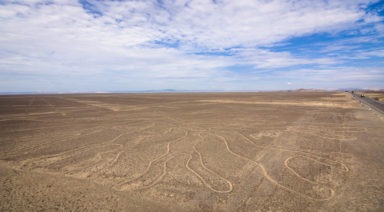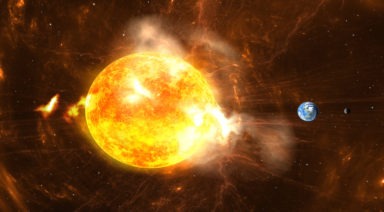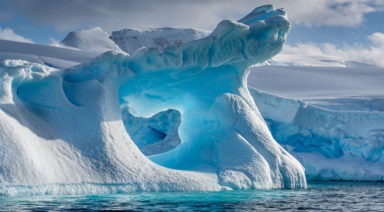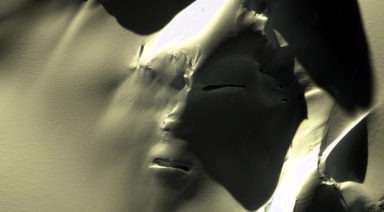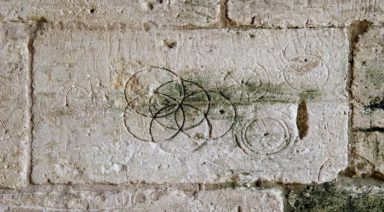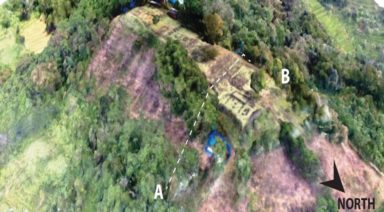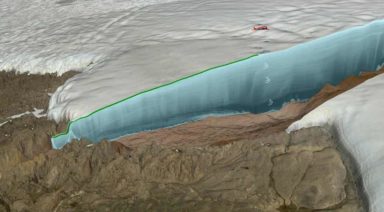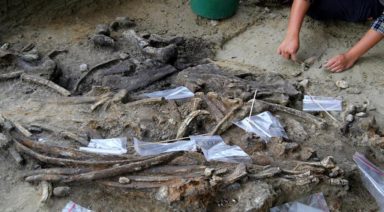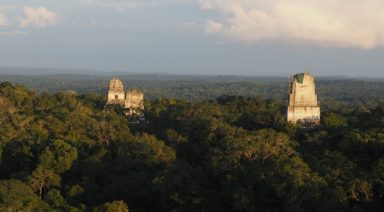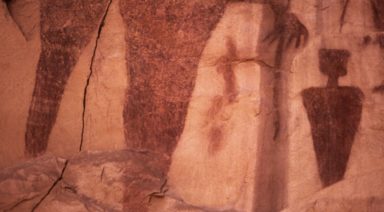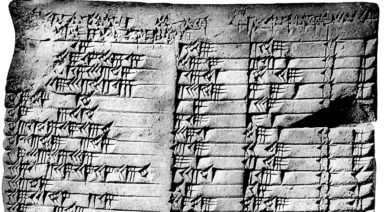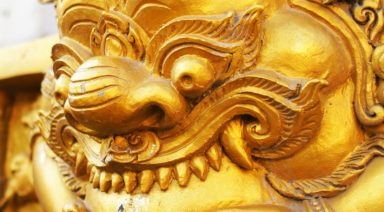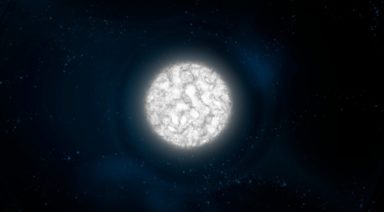Powerful Evidence of Nuclear Wars in Ancient Times

History views the 1945 Trinity atomic bomb test as a civilization’s entry into the nuclear age. But the archaeological and geologic records, ancient literature, and even the words of Robert Oppenheimer himself, force investigators to consider puzzling evidence that begs the questions; has Earth been the site of ancient nuclear wars? Did humanity blast itself back to the stone age? Will we do it again?
The Trinity Test
After the 1941 Japanese Pearl Harbor attack, the U.S. triggered the Manhattan Project, a “crash” weapons research program. One of the programs under the Manhattan Project was Trinity, directed by theoretical physicist Robert Oppenheimer, dedicated to weaponizing nuclear fission as quickly as possible.
Oppenheimer was successful. On July 16, 1945, his agency detonated a test plutonium bomb at the White Sands Proving Grounds. One witness reported; “The lighting effects beggared description. The whole country was lighted by a searing light with the intensity many times that of the midday sun. It was golden, purple, violet, gray, and blue. It lit every peak, crevasse, and ridge of the nearby mountain range with a clarity and beauty that cannot be described but must be seen to be imagined.”
The Trinity explosion crater was 300 ft. wide and five ft. deep. Inside was a green, glassy material indicating temperatures of 3,090F., or 1,700C., the minimum needed to melt sand into glass. This radioactive glass was named “Trinitite,” and was considered a unique material found nowhere else on earth.
Later, when questioned whether Trinity was the first-ever detonation of an atomic device, the inscrutable Oppenheimer replied, “Yes, in modern times.” Since then, much has been made of Oppenheimer’s words that beg the question, “And prior to modern times?” Did Oppenheimer suspect there had been a prehistoric nuclear war? If he did, he had a good reason.
Oppenheimer: Student of Sanskrit and Vedic Literature
Enthralled by the Bhagavad-Gita, the great Indian war epic written around the second century BCE, Oppenheimer began Sanskrit studies so he could read the text in its original language. While he was a professor, prior to WWII, he was known to quote passages from the Mahabharata in every class lecture.
While much is made of the Bhagavad-Gita as a mythic, spiritual saga, Oppenheimer, as a student and professor of theoretical physics and thermodynamics, was likely captivated by the explosive, burning weapons and devices described in detail — so precisely that modern researchers have been able to “reverse engineer” those technologies.
Were the Magical Weapons of the Mahabharata Nuclear Bombs?
One section of the Bhagavad-Gita, called the “Book of Drona,” describes ‘magical’ weapons, called “astra,” that could destroy entire armies, “causing crowds of warriors with steeds and elephants and weapons to be carried away as if they were dry leaves of trees.” Another weapon was described as producing vertical, billowing smoke clouds that opened consecutively like giant umbrellas, reminiscent of the massive rising mushroom clouds produced by the Trinity test.
Among the most destructive of the astra was the “brahmastra,” created by the god Brahma, a “single projectile charged with all the power in the universe. It was an unknown weapon, an iron thunderbolt, a gigantic messenger of death which reduced to ashes an entire race. There was neither a counter attack nor a defense that could stop it.”
The weapon produced “an incandescent column of smoke and flame as bright as 10,000 suns that rose in all its splendor. After, corpses were so burned as to be unrecognizable. Their hair and nails fell out; pottery broke without any apparent cause, and the birds turned white… After a few hours, all foodstuffs were infected.
“Any target hit by the brahmastra would be utterly destroyed; land would become barren and lifeless, rainfall would cease, and infertility in humans and animals would follow for aeons of time.”
The brahmastra was detonated at the end of the final 18-day battle of Kurukshetra. The Pandavas vanquished their enemy, the Kauravas, with the devastating weapon, but the few surviving Pandavas discovered that there was nothing left to occupy, and no one left to rule. The brahmastra had destroyed the entire Kauravas society and turned the region (present-day Rajasthan) to desert. The war also marked, in the Vedic system, the beginning of the current “Kaliyuga” age.
Trinity Test Eyewitness Accounts
Declassified eye-witness accounts of the Trinity nuclear test echo the ancient descriptions of the brahmastra. L.W. Alvarez was sitting between the pilot and co-pilot of a B-29 flying roughly 25 miles from the blast site. He said, “Intense light covered my field of vision, after which I noted an orange-red glow. The cloud started to push up, appearing as a parachute being blown up by a large electric fan.”
Ten miles from the blast, witness Enrico Fermi reported, “I had the impression that suddenly the countryside became brighter than full daylight.” Technician Kenneth Griesen, also ten miles from the site, saw “a brilliant yellow-white light all around. A tremendous cloud of smoke was pouring upwards, some parts having brilliant red and yellow colors, like clouds at sunset.”
Phillip Morrison reported that “what I saw first was a brilliant violet glow. Immediately after this brilliant violet flash, I observed an enormous, brilliant disk of white light, a color much whiter, and several times brighter than the noon sun.”
Trinity Test Fallout and Aftermath
While the U.S. Government publicly described the White Sands Proving Grounds region as uninhabited, there were actually around 40,000 people, including Mescalero Apache, living in the counties surrounding the test site. Many saw the explosion and displayed health impacts shortly after the blast — crops, and livestock were immediately contaminated.
A Popular Science article tells the story of Darryl Gilmore, from Tularosa, a small town on Highway 380 near the Trinity site. Gilmore was driving home from Albuquerque the morning of the test. He said he didn’t see the dawn flash before he left, but encountered military personnel on the highway who told him to roll up his windows, as there was poison gas in the area. Soon after, his arms, neck, and face turned sunburn red. “My outer skin gradually fell off the next few days. A few years later I began to have skin problems, and I’ve had treatments ever since,” he said. Gilmore has also survived prostate and other cancers.
New Mexico is known for a high number of cancer deaths — in fact, cancer is the state’s leading cause of death. An October 2017 study from the University of Arizona, “Measuring the Effect of Atmospheric Nuclear Testing on American Mortality Patterns,” stated that “the cumulative number of excess deaths attributable to these tests is comparable to the bombings of Hiroshima and Nagasaki,” citing 340,000 to 460,000 deaths that were directly or indirectly caused by tests.
Impacts: Hiroshima and Nagasaki
A more direct comparison to the brahmastra destruction is the aftermath of the nuclear bombing of Hiroshima and Nagasaki. After Trinity, the U.S. didn’t waste any time deploying the new atomic technology — less than three weeks later, on Aug. 6, 1945, the U.S. Air Force dropped an atomic weapon, nicknamed “Little Boy,” on Hiroshima, Japan. Immediately, a reported 70,000 people were killed, with another 140,000 dying of radiation poisoning by 1946.
The core destruction radius was about a mile around ground zero. Fires were reported across an additional 4.4 sq. miles. Humans and animals in the blast zone turned to carbon, echoing the words of the Mahabharata; “corpses so burned as to be unrecognizable.” Others were killed by flying projectiles and fires. A few days later, the Nagasaki bombing produced the same death and devastation.

L: Pectoral with desert glass scarab attributed to Tutankhamen’s burial collection. R: Sample of desert glass from Libya or Egypt.
Physical Evidence of Ancient Nuclear Wars: Desert Glass
When the Trinity team discovered the green glass in the bomb craters, they named the material “Trinitite.” The glass also called “nuclear,” “atomic,” and “desert” glass, was formed when silica sand was heated to temperatures above 1,700 degrees centigrade by the blast.
After the Trinity test, engineer Albion Hart noticed that the Trinitite was identical to the material he had seen in the African desert decades earlier. He calculated that the size of the African glass deposit indicated a blast ten thousand times more powerful than the Trinity bomb. The similarities were dismissed, as no one believed an ancient or modern blast of those proportions as possible.
Earlier, In 1932, an Egyptian Geological Survey team member Patrick Clayton was driving across the desert near the Saad Plateau. He said he heard a “crunching” under the wheels of his car; unusual, in that he was driving on sand surfaces. He stopped and discovered large pieces of glass in the sand.
The glass has also been found under Neolithic, Sumerian, and Babylonian layers at archaeological sites in Iraq. Is it possible that an ancient civilization prior to the Neolithic period blew itself back to the stone age with nuclear devices?
Libyan desert glass deposits, estimated to be 28.5 million years old, stretch over 6,500 square kilometers into neighboring Egypt. The light green Libyan glass, called “the rock of god,” was so gem-like and crystal clear it was used in royal Egyptian jewelry. Ten thousand-year-old paleolithic tools made from desert glass have been found in Egypt and throughout North Africa.
Desert Glass Created by Lighting and Meteors?
Mainstream science asserts that desert glass (other than White Sands) is the product of ancient meteor and lightning strikes, but others have debunked these theories.
Meteor strikes leave impact craters and meteoric iron fragments as well as tektite stones, generally opaque gray or brown because of the presence of iron and other minerals. While a meteor may burn at temperatures hot enough to melt sand into the tektite glass, the remnants generally take the form of tiny glass “beads” rather than widespread layers and slabs.
Lightning can be hot enough to fuse silica, but the resulting glass takes the form of the strike tunneling into the ground and looks like many-branched coral with a sandy coating.
While the Trinity bomb left a crater, post-test bombs were detonated well above ground, as Oppenheimer’s team discovered mid-air detonation maximized damage. The Hiroshima bomb detonated at 600 meters (2,000 ft.) above ground, and the Nagasaki bomb exploded 500 meters (1,620 ft.) above ground. Aerial detonation minimizes ground craters, consistent with an absence of craters at desert glass deposits.
Ancient Radioactive Sites in India and Pakistan
Ten miles west of Jodhpur, a city in the Northern Rajasthan region of India, a three-square-mile radioactive zone was discovered during excavation for a housing project. Under the ground surface were a layer of highly radioactive dust and ash in a circular pattern, “consistent with what occurs underneath a typical air-burst nuclear detonation.” The housing project was canceled, but coincidentally, in 2016, India’s Defense Research and Development Organization (DRDO) built a laboratory at Jodhpur to develop a drone-mounted radioactivity sensor.
In what is now Pakistan, the ruins of two ancient cities, Harappa and Mohenjo-Dara, were discovered in the 1920s. The two sites were dated to around 2,500 BCE. Archaeological excavation began, and when the dig reached the original street level, 44 skeletons were found sprawled in the ancient roadways. A researcher, David Davenport, found what would have been a blast epicenter, “a 50-yard radius at the site where all objects were found to have been fused and glassified.” Another researcher reported at least one skeleton that had “50 times the level of radiation is should have had.”
After the discoveries, there was official silence on the topic, aside from explanations that included a meteor strike, nuclear testing, and other scenarios. What was interesting was the 1983 National Cancer Registry report stating that leukemia and skin, bone, and prostate cancer occurrences were much higher in Jodhpur than the rest of the country.
While officials and mainstream scientists continue to find alternate explanations for anomalies like desert glass, radioactive skeletons, ancient nuclear dust, and ash, etc., the simplest explanation is that at some point in distant human history, radioactive devices were detonated. As a scientist, Oppenheimer would have been familiar with the Occam’s Razor principle — if there are multiple explanations for a mystery, the simplest solution is likely to closest to the truth.
Has The Lost Ark of the Covenant Been Found in Israel?
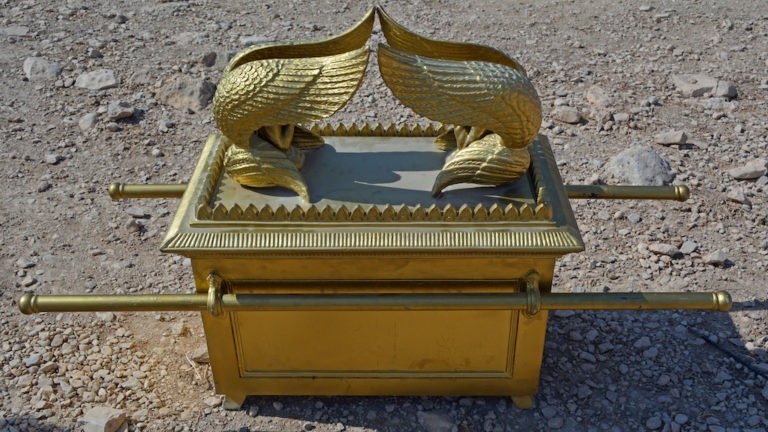
The ancient city of Ekron — later to be renamed Lod — was known as one of five great Philistine cities, founded in the 12th century B.C.E. in Southwestern Canaan. Under Assyrian rule, it had become the largest olive-oil production center in the ancient Near East. Biblically speaking, wrote one historian, Ekron was the last place to which they carried the Ark of the Covenant before it was returned to Israel (1 Samuel 5:10; 6:1-8). The Ark is said to have been wrested from the Children of Israel during a battle, but as its new guardians experienced unexpected catastrophes they feared resulted from its presence, the Philistines had decided it was too much trouble to keep. Here we are, thousands of years later, and Israeli archaeologists may have stumbled upon a clue to the Ark’s actual existence.
The Ark’s Illustrious History
The Bible states that the Ark of the Covenant found its first resting place in Siloah, near Jerusalem, after the ancient Jews had expelled the Canaanites from the Promised Land. And then, after losing a battle to the Philistines, the Ark was captured. God punished the Philistines with a plague, and the artifact was returned to the Israelites, who placed it in Beth Shemesh, where it remained for years before King David had it taken to rest in Jerusalem.
National Geographic reporters Richard Lovett and Scot Hoffman wrote that, according to Biblical accounts, the Ark was about the size of a 19th-century seaman’s chest, made of gold-plated wood and topped with two large, golden angels. It was carried using poles inserted through rings on its sides.


